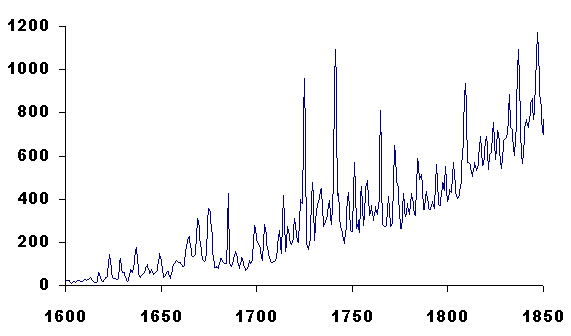
Manx Registers are non-existant pre 1600, only Ballaugh, Jurby and Michael have burial and baptismal registers covering most of the 17th Century; by 1625 Braddan, Marown and Onchan provide Burials, by about 1650 Malew, Maughold and Ballure Chapel Ramsey are available, many of the remainder of the parishes are only complete by early into the 18th Century.
The following plot shows the number of burials/year on the Island - based on the index to all Island Burials compiled by Brian Lawson using the transcriptions of the various Burial Registers by the IoM Family History Society. Many Parish Registers are deficient before 1700. All dates have been converted to new style years - i.e. those shown as 1741 cover the period from Jan 1 1740/1 through to Dec 31 1741. (Internally my database uses a modified form of Julian Day) - all plots should be histograms, however a smoothed curve going through the data points has been choosen for ease of display.

Several peaks are immediately obvious
Some of these post 1650 would appear to be smallpox - this was generally noted as such in many Registers; other notes in the Registers as to cause of death are to 'flux' or dysentry (like smallpox a major killer of young children). As an example in a short loose note inserted in the 1827 copy of Andreas Parish Register there is the following information about Andreas Burials (P was presumably Small Pox but only 1765 explicitly mentions smallpox) :
1704 45; 31 P beginning Aug 5 ending Nov 8
1713 23; 11 are P beginning Feb2 ending Mar 24
1714 36; 25 are P beginning Mar 25 end May 22
1725 70; 47 are P inc Edward and Alex two of Archdeacon Horrobin's children com Jul 14 end Jan 2d
1764 31: 8 are P com 28 Aug 31 Dec
1765 44: 19 small P com 2 Jan end 25 Apl
1723 57: 32 common distemper of stitch of pleurisy [Inflammation of the pleura, the lining of the chest cavity. Symptoms are chills, fever, dry cough, and pain (or 'stitch') in the affected side]
1755 20: 9 died of chin cough [wooping cough] which all over the country was very severe
1832 saw the outbreak of Cholera - note however that more died in 1837, Patin suggests that these were also due to Cholera, however they were probably due to Typhus.
Before looking for a reason it is necessary to locate a crisis in the records - an increase in the number of burials in a specified period (eg 12 months) of 2 or more times that of the same period in surrounding years is an easily distinguished sign though care must be taken if using yearly figures to recognise that many crises may overlap two years and that the harvest year (September through to next August) may be a better indicator.
These crises may be caused by two major reasons - starvation (and famine-related disease) and epidemics. In England actual famine may be discounted after the mid 17th century as measures would be in place to move grain from within the British Isles (eg Ireland) or to import grain from typically the Baltic (or later from North America). Before this period the grain trade was more localised and though organised in such a way to supposedly protect the poor by preventing purchases by speculators and merchants from outside the local market area it could exacerbate localised shortages unless the authories took action. According to Moore (Bk 2 Chap 4 pt 1) grain prices on Mann were consistently and considerably lower than English prices (though here Appleby notes that regional differences would exist and it is not clear to which figures Moore made comparison) - presumeably the Island laws against stranger Merchants and the cost of transport kept external merchants out of the market.
Appleby suggests 8 necessary indicators of starvation as a major factor:
Until the 18th century when the potato became increasingly important, the major foodstuff was bread grains, wheat being the preferred choice but for the poor barley and oats were more common. Protein rich peas and beans were introduced into mediaeval England and by the 16th century were a significant part of the diet. Meat was generally too expensive for the poor though on the Island fish (especially the herring) was a significant component.
Detailed examination of various years are covered elsewhere
R.A. Houston The Population History of Britain and Ireland 1500-1750, Macmillan Education Studies in Economic and Social History (ISBN 0-333-56564-9) 1992
E. A. Wrigley, R. S. Davies, J. E. Oeppen, R. S. Schofield English Population History from Family Reconstitution 1580-1837 (Cambridge Studies in Population, Economy and Society in Past Time)
E. A. Wrigley, R. S. Schofield The Population History of England 1541-1871,
|
|
||
|
|
||
|
Any comments, errors or omissions gratefully received
The Editor |
||